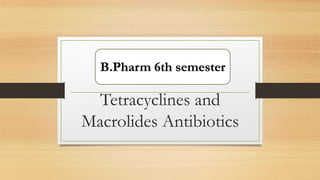
Tetracyclines, Macrolides, Chloramphenicol and Clindamycin Antibiotics for Pharmacy and Medical Students .pptx
- 1. Tetracyclines and Macrolides Antibiotics B.Pharm 6th semester
- 2. Introduction to Tetracyclines: Definition and historical background: Tetracyclines are a class of antibiotics derived from Streptomyces bacteria. They were first discovered in the 1940s and have since become widely used in medicine. Classification and structure: Tetracyclines are classified based on their chemical structure into various subgroups, including tetracycline, doxycycline, minocycline, and others. They share a common core structure and belong to the broader group of polyketides. Mechanism of Action: Inhibition of bacterial protein synthesis: Tetracyclines inhibit protein synthesis in bacteria by binding to the 30S ribosomal subunit, thereby preventing the attachment of aminoacyl-tRNA to the mRNA-ribosome complex. Binding to the 30S ribosomal subunit: Tetracyclines bind reversibly to the 30S ribosomal subunit of bacteria, interfering with the elongation of the polypeptide chain during protein synthesis.
- 4. 1.Spectrum of Activity: 1. Broad-spectrum antibiotic coverage: Tetracyclines exhibit broad-spectrum activity against a wide range of bacteria, including both Gram-positive and Gram- negative species. 2. Effective against both Gram-positive and Gram-negative bacteria: Tetracyclines are effective against many bacterial pathogens, including Staphylococcus aureus, Streptococcus pneumoniae, Escherichia coli, and Chlamydia trachomatis. 2.Indications for Use: 1. Treatment of various bacterial infections: Tetracyclines are used to treat a variety of bacterial infections, including respiratory tract infections, urinary tract infections, and skin infections. 2. Specific diseases targeted: Tetracyclines are also used to treat specific diseases such as acne vulgaris, Lyme disease, and sexually transmitted infections like chlamydia and gonorrhea.
- 5. Stereochemistry of Tetracyclines Carbon atoms 4, 4a, 5, 5a, 6, and 12a are potentially chiral, depending on substitution Classifications Of Tetracyclines
- 7. Tetracyclic Nucleus: The core structure of tetracyclines is a four-ring system where each ring is six- membered. This tetracyclic backbone is crucial for antibacterial activity1. Ring A Modifications: C-1 and C-3: These positions are involved in keto-enol tautomerism. Modifications here usually result in a loss of antibacterial activity1. C-2: The carboxamide moiety at this position is important. Large substitutions can disrupt the keto- enol equilibrium and reduce activity1. C-4: Typically has a dimethyl-amino group. Altering this group can lead to a loss of activity1. Ring B and C: Changes in these rings are tolerated as long as the keto-enol systems remain intact and conjugated with the phenolic D-ring1. Ring D: Needs to be aromatic, and its phenolic nature is imperative for activity1. Other Positions: C-4a: The α-hydrogen here is necessary for antibacterial activity1. C-5 and C-5a: Alkylation at C-5 usually leads to a loss of activity. However, oxytetracycline, with a hydroxyl group at C-5, is an exception and is quite potent1
- 8. Adverse Effects: 1. Common side effects: Common side effects of tetracyclines include gastrointestinal disturbances (e.g., nausea, vomiting, diarrhea), photosensitivity, and rash. 2. Rare but serious adverse reactions: Rare but serious adverse reactions include hepatotoxicity, nephrotoxicity, and potentially life-threatening allergic reactions.
- 9. 1.Drug Interactions: 1. Interaction with other medications: Tetracyclines may interact with other medications, such as antacids, dairy products, and certain vitamins, reducing their absorption or efficacy. 2. Importance of avoiding concomitant use with certain drugs: Concomitant use of tetracyclines with drugs like oral contraceptives or anticoagulants may reduce their effectiveness, necessitating caution and potential dosage adjustments. Contraindications
- 10. Clinical Considerations: •Dosing regimens and administration routes: Tetracyclines are typically administered orally, although intravenous formulations are available for certain indications. Dosing regimens vary depending on the specific tetracycline and the type and severity of infection. •Monitoring for therapeutic efficacy and adverse effects during treatment: Patients should be monitored for both therapeutic efficacy (resolution of infection) and adverse effects (e.g., liver and kidney function tests, monitoring for signs of superinfection).
- 11. Pharmacokinetics: 1. Absorption, distribution, metabolism, and excretion: Tetracyclines are well-absorbed orally and widely distributed in body tissues. They undergo hepatic metabolism and are primarily excreted through the kidneys. 2. Factors affecting absorption and bioavailability: Absorption of tetracyclines can be affected by food, calcium-containing products, and certain medications. They have variable bioavailability and may require dose adjustments in patients with renal impairment.
- 16. MOA Of Macrolides antibiotics
- 19. Chloramphenicol 1. Chloramphenicol is a broad-spectrum antibiotic first discovered in 1947, prized for its efficacy against various bacterial infections. 2. It inhibits bacterial protein synthesis by binding to the 50S ribosomal subunit, making it a bacteriostatic agent. 3. Despite its effectiveness, chloramphenicol carries risks of serious adverse effects, including aplastic anemia, limiting its use to specific cases. 4. It remains a vital antibiotic in treating typhoid fever, bacterial meningitis, and certain other infections, especially in areas with limited antibiotic options. 5. Chloramphenicol resistance has emerged due to widespread use and misuse, prompting caution in its administration to prevent further resistance development. 6. Continuous surveillance and prudent use strategies are essential to preserve chloramphenicol's utility while minimizing the risk of adverse effects and antibiotic resistance.
- 26. Clindamycin Clindamycin is an older antibiotic that is used to treat bacterial infections including pneumonia, strep throat, osteomyelitis, and endocarditis. It was first synthesized in 1966 by Barney J. Magerlein*, Robert D.
- 27. 1. Chloramphenicol exhibits a narrow spectrum targeting anaerobic bacteria, gram-positive cocci and bacilli, and select gram-negative bacilli. 2. Clindamycin, while related, displays activity against protozoans, with off- label applications in treating toxoplasmosis, malaria, and babesiosis. • Good G-I absorption • Does Not Cross BBB • Increases Bone Penetration
- 29. Brand Names Medicines Of Clindamycin
- 30. Thank you
- 31. References:- Ruiz NM, Rámirez-Ronda CH. Tetracyclines, macrolides, lincosamides & chloramphenicol. Bol Asoc Med P R. 1990 Jan;82(1):8-17. PMID: 2180420. Smilack JD, Wilson WR, Cockerill FR 3rd. Tetracyclines, chloramphenicol, erythromycin, clindamycin, and metronidazole. Mayo Clin Proc. 1991 Dec;66(12):1270-80. doi: 10.1016/s0025- 6196(12)62479-3. PMID: 1749296. https://www.slideshare.net/slideshow/tetracyclines-aminoglycosides-chloramphenicol-macrolides/103702471 Scholar, Eric M, and William B Pratt, 'Bacteriostatic Inhibitors of Protein Synthesis: Chloramphenicol, Macrolides, Clindamycin, Spectinomycin, Tetracyclines and Streptogramins', The Antimicrobial Drugs (New York, NY, 2000; online edn, Oxford Academic, 31 Oct. 2023), https://doi.org/10.1093/oso/9780195125283.003.0006, accessed 28 Apr. 2024.
